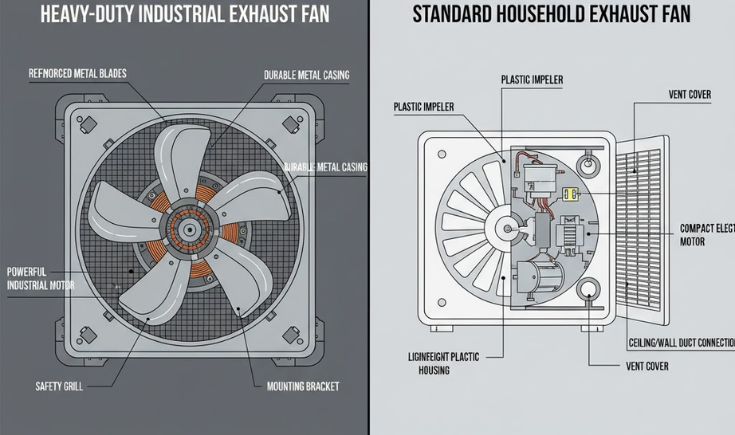- Gala No. 19, 2nd Floor,
Bail Bazar, Mumbai, India - +91 88 5002 0455
info@alfafans.in


Proper ventilation is essential for maintaining air quality, reducing heat, and ensuring safety in homes, commercial buildings, and industrial spaces. When it comes to choosing an exhaust fan, heavy-duty and standard exhaust fans are two popular options. But which one is right for your space? Understanding the key differences can help you make an informed decision.
In this article, we’ll break down the differences, advantages, and ideal use cases of heavy-duty vs standard exhaust fans.
A standard exhaust fan is designed for regular ventilation needs in residential or light commercial settings. These fans help remove stale air, smoke, moisture, or odors from kitchens, bathrooms, or small offices.
Heavy-duty exhaust fans are engineered for industrial, commercial, and large-scale ventilation requirements. They are built to handle high airflow volumes, remove heat, and maintain air quality in demanding environments like factories, warehouses, workshops, and large kitchens.
| Feature | Standard Exhaust Fan | Heavy-Duty Exhaust Fan |
|---|---|---|
| Airflow Capacity | Moderate (suitable for small rooms) | High (large spaces & industrial use) |
| Durability | Designed for light use | Built for continuous, heavy use |
| Construction | Plastic or light metal | Heavy metal, corrosion-resistant |
| Noise Level | Usually quieter | May be louder due to larger motors |
| Cost | Affordable | Higher initial investment |
| Applications | Bathrooms, kitchens, small offices | Factories, warehouses, commercial kitchens |
| Maintenance | Minimal | Requires regular inspection due to heavy usage |
Standard exhaust fans are perfect for:
Heavy-duty exhaust fans are ideal for:
Choosing between heavy-duty and standard exhaust fans depends on your space, ventilation needs, and operational requirements. Standard fans are cost-effective and perfect for small-scale applications, while heavy-duty fans provide powerful ventilation, durability, and flexibility for large or industrial spaces.
By understanding these differences, you can ensure efficient airflow, enhanced air quality, and long-term performance in any environment.